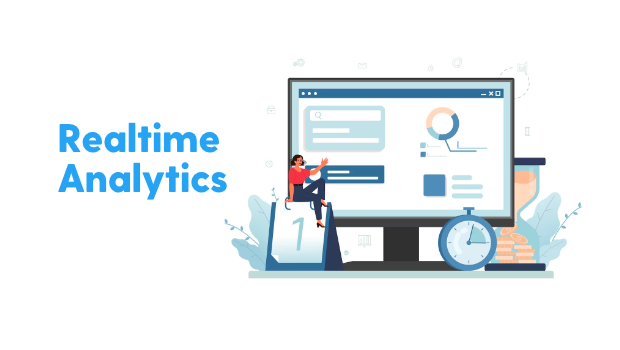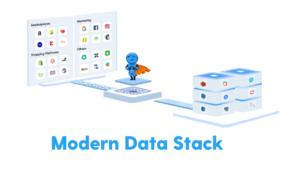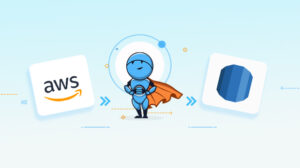Real time analytics refers to the process of collecting, analyzing, and making decisions on data as it is generated, rather than after it has been collected and stored. This allows organizations to respond quickly to changing conditions and take advantage of new opportunities as they arise. Some common use cases for real-time analytics include detecting fraud, optimizing supply chain operations, and providing personalized recommendations to customers.
The technologies used to support real-time analytics include stream processing platforms, in-memory databases, and complex event processing (CEP) systems. These tools allow organizations to ingest and process large volumes of data in near real-time, and then make that data available to other systems and applications for analysis and decision-making.
Real-time analytics is also used in different industry for example finance, healthcare, eCommerce, and telecommunication for real-time fraud detection, customer churn prevention, risk assessment, and anomaly detection.
To implement a real-time analytics system, an organization typically needs to have a strong data infrastructure in place, including data storage, data processing, and data visualization tools. Along with a modern data stack, the organization should have a team of data scientists, engineers, and analysts who are experienced in working with real-time data and can build and maintain the necessary analytics models.
Types of Real-Time Analytics
There are several types of real-time analytics that can be used to analyze data and make decisions quickly. Six types of real-time analytics are:
- Stream Processing: This type of real-time analytics involves continuously analyzing data as it is generated and flowing into the system, such as sensor data or social media feeds. Stream processing frameworks like Apache Kafka and Apache Storm allow for analyzing and acting on data in near real-time.
- Complex Event Processing (CEP): CEP is a type of event-driven computing that analyzes high-volume, high-velocity data streams to identify patterns and trends, and trigger actions in response to specific patterns or events. CEP systems like Apache Flink and Esper are designed for handling high-throughput and low-latency data streams.
- Operational Intelligence: Operational intelligence (OI) is the ability to turn data from the IT operations of a business into actionable insights. Operational Intelligence solutions like Splunk, LogRhythm and IBM QRadar provide real-time monitoring, correlation and analysis of IT data, which can be used to optimize IT operations and resolve issues quickly.
- Predictive analytics: This type of analytics, often used with machine learning algorithms, aims to predict future events using historical data as well as other data inputs. Examples include real-time forecasting, anomaly detection, churn prediction.
- Decision Support Systems (DSS) : DSS are interactive computer-based systems that support decision-making activities. they can be in the form of dashboards, reports, alerts and visualizations.
- Business Intelligence (BI): BI systems, often include real-time data feeds, can provide near-instant insights into business operations. They can also be used to track and analyze key performance indicators (KPIs) and other metrics in real-time, often through dashboards and visualizations.
Six Use-Cases of Real-Time Analytics
- Fraud Detection: Real-time analytics can be used to detect suspicious patterns and anomalies in financial transactions, such as unusual spending patterns or unusual account access. This allows organizations to quickly identify and respond to potential fraud.
- Customer behavior tracking: Real-time analytics can be used to track customer behavior, such as website clicks and purchases, in order to better understand customer needs and preferences. This can be used to provide personalized offers and recommendations, or to identify potential issues before they escalate. Read more – Customer Data Platform
- Real-time inventory management: Real-time analytics can be used to track inventory levels in real-time and automatically reorder items as they run low. This can help organizations avoid stockouts and optimize inventory levels to reduce waste and costs.
- Predictive maintenance: Real-time analytics can be used to predict when equipment is likely to fail, based on patterns of usage and performance. This can help organizations schedule maintenance proactively, rather than waiting for equipment to break down.
- IoT device monitoring: Real-time analytics can be used to monitor the performance and status of IoT devices, such as industrial sensors or smart home devices. This can help organizations identify and respond to issues in real-time, such as sensor failure or intrusion detection.
- Energy management: Real-time analytics can be used to monitor and optimize energy usage in buildings, power plants and factories. Real-time monitoring can be used to detect and respond to energy waste, or to optimize energy usage to reduce costs or improve sustainability.
Key Technologies for Real time Analytics
Few key technologies for real-time analytics along with a brief description are given in the table below:
| Technology | Description |
| Distributed computing frameworks | Apache Kafka and Apache Storm are popular distributed computing frameworks that can be used for real-time data processing. They are designed to handle large volumes of data and can process and analyze data streams in real-time. Apache Kafka is a messaging system that allows for the reliable and fault-tolerant transfer of data between systems, while Apache Storm is a distributed real-time computation system that can process and analyze data streams. |
| In-memory databases | Apache Ignite, SAP HANA, and Redis are examples of in-memory databases that can be used for real-time analytics. These databases are designed to store and process large amounts of data in memory, which allows for faster access and processing times than traditional disk-based databases. This makes them suitable for real-time analytics workloads. MemSQL, VoltDB are some other examples that are built to handle OLAP and OLTP workloads. |
| Streaming analytics platforms | Apache Spark Streaming, Apache Flink, Apache Samza are examples of streaming analytics platforms that can be used for real-time data processing. They are designed to process and analyze large volumes of data in real-time, and can handle both batch and streaming data. Both of them can process data streams in real-time, but Apache Flink is considered to be more powerful for streaming workloads and it supports both batch and stream processing. Apache Samza is more suited for stream processing with lower-latency requirements and can integrate with other systems like Apache Kafka and Apache Cassandra. |
| NoSQL Databases | MongoDB, Cassandra, Riak, Hbase are examples of NoSQL databases that can be used for real-time analytics. They are designed to handle large amounts of unstructured data and can scale horizontally to handle high-velocity data streams. These databases are good at handling high-read, high-write workloads, which is ideal for real-time analytics use cases. They also come equipped with built-in support for advanced analytics, monitoring, and scale-out. Couchbase and Aerospike are other examples that can handle high performance use cases. |
| Columnar Database | Columnar databases like ClickHouse and Parquet are designed to handle analytical workloads. They have high compression ratios, query optimization and columnar storage which makes them more suitable for handling large data sets, faster read/write and low-latency queries. They can also be integrated with distributed computing frameworks like Apache Kafka, Apache Spark, and Apache Flink. |
| Data Warehousing | Real-time data warehousing solutions like Amazon Redshift, Google Bigquery and Snowflake, enable you to store and query your data in real-time and handle petabyte scale data. They can integrate with other technologies like Kafka, Spark and Flink and enable real-time data loading and querying. |
Challenges and Best Practices for Real-Time Analytics
Let’s look at some key challenges and corresponding best practices for real-time analytics:
- Handling high volume, velocity, and variety of data: Real-time analytics systems must be able to handle large amounts of data at high speeds, and from a variety of sources such as social media, IoT devices, and logs. This can be challenging because it requires a high-performance data pipeline, as well as the ability to handle data in various formats, such as structured, semi-structured, and unstructured data.Best practices include choosing a distributed computing framework, such as Apache Kafka or Apache Storm, that can handle high-volume data streams, and using a data lake or data warehouse that can store and process large amounts of data.
- Low latency and high availability requirements: Real-time analytics systems must be able to process and analyze data quickly, in order to make decisions in near real-time. Additionally, the system should be highly available, so that it can continue to operate even in the face of hardware failures or other issues. To achieve this, best practices include choosing in-memory databases, such as Apache Ignite or SAP HANA, and using distributed computing frameworks, such as Apache Kafka or Apache Storm, that are designed for low-latency and fault-tolerance.
- Ensuring data accuracy and completeness: It’s important to ensure the data used for real-time analytics is accurate and complete, so that the resulting insights and decisions are reliable. This requires data quality management, data cleaning, and data validation.Best practices include implementing data quality checks at various stages of the data pipeline, such as data ingestion, data processing, and data analysis. Additionally, implementing a data governance framework can help ensure data is accurate, complete, and secure.
- Building real-time analytics pipeline: Building a real-time analytics pipeline can be a complex process, especially when dealing with large volume, velocity, and variety of data. It requires selecting the right technologies, integrating and configuring them properly, testing and deploying them and maintaining them. To achieve this, best practices include using open-source technologies, such as Apache Kafka, Apache Storm, and Apache Spark, which are well-supported and have large communities of developers and users, and following a DevOps approach to software development and deployment, which can help accelerate the process and make it more efficient.
- Choosing the right technology stack: Real-time analytics systems can be built using a variety of technologies, each with its own strengths and weaknesses. Choosing the right technology stack depends on the specific use case, the requirements of the system, and the available resources.
Best practices include evaluating the various technologies available and their capabilities, testing different technology stacks, and selecting the one that best meets the requirements of the system. Additionally, it is important to consider the scalability, ease of integration, and maintainability of the technology stack.
Real-time Analytics in eCommerce & Retail
In the eCommerce and retail industry, real-time analytics can play a critical role in informing business decisions and driving growth. One approach to implementing real-time analytics is to use an ELT (Extract, Load, Transform) tool to consolidate data from various sources, such as website logs, order management systems, inventory management systems, marketing platforms, and social media, into a single data warehouse for storage and analysis. By leveraging an ELT tool like Daton, eCommerce businesses can easily integrate data from multiple systems and platforms, and then use that data to generate automated, real-time reports on key metrics such as website traffic, customer behaviour, advertising spend, sales and inventory levels, and customer sentiment.
By analyzing this data in real-time, eCommerce businesses can gain insights into customer behavior and preferences, and use that information to optimize their marketing, sales and inventory management strategies. This can help them to improve website conversion rates, increase customer retention, reduce customer acquisition costs, and optimize inventory levels, which can all contribute to revenue growth. Additionally, real-time analytics can help eCommerce businesses to quickly identify and respond to any issues or trends that may impact their business, such as a sudden drop in sales or a spike in customer complaints.
Data warehouse specifically designed for real-time data and analytics such as Data lake, Data Mart or a Cloud data warehouse can be deployed to store the data, and a Business intelligence (BI) platform can be used to generate automated, real-time reports, dashboard and alerts which can be accessible to decision-makers across the organization. This can help to ensure that key insights are communicated and acted upon in a timely manner.
For example, an eCommerce business may use real-time analytics to track which product pages are receiving the most traffic, and then use that information to optimize those pages by making them more visually appealing, providing more detailed product information, or highlighting related products. Additionally, they can use the data to understand which products are being viewed the most, and which products customers are most likely to purchase. Based on this information, the business can then adjust their inventory management strategy to ensure that the most popular products are always in stock.
Another example is the ability to monitor the performance of their online advertising campaign in real-time. By analyzing real-time data from online advertising platforms, eCommerce businesses can identify which ads are performing well, and which are not. They can then adjust their advertising strategy by allocating more budget to the ads that are performing well, or by optimizing the ads that are underperforming to improve their performance.
In both examples, real-time analytics allows eCommerce businesses to quickly identify and respond to changes in customer behavior and advertising performance, allowing them to make data-driven decisions that can have a positive impact on their bottom line.
Future of Real Time Analytics
The future of real-time analytics looks promising, as more and more companies are recognizing the benefits of real-time data and insights. As technology continues to advance, it is expected that real-time analytics will become more prevalent and easier to implement. Here are a few potential future developments in the field of real-time analytics:
- Cloud-based analytics: The increasing adoption of cloud computing and cloud data storage is likely to make it even easier for businesses of all sizes to implement real-time analytics. Cloud-based analytics solutions can provide the scalability and flexibility needed to handle large amounts of data, and can be accessed from anywhere with an internet connection.
- Advanced machine learning and AI: In the future, real-time analytics is expected to be further enhanced by the use of advanced machine learning and AI algorithms, which will be able to process large volumes of data and make predictions in real-time. It will help to identify patterns, trends and insights that might otherwise be missed by human analysts.
- Internet of Things (IoT): As more and more devices become connected to the internet, the amount of data generated by these devices is expected to continue to grow, creating new opportunities for real-time analytics. By analyzing data generated by connected devices, businesses will be able to gain real-time insights into their operations, and use that information to optimize processes and improve efficiency.
- More real-time engagement and Automation: With the increasing ability of real-time analytics to handle data from various sources, there will be the ability to create real-time engagement opportunities with customers, such as chatbot-based customer support and personalized product recommendations. As well as automation of business processes, such as inventory management, logistics and forecasting.
- Edge computing: Edge computing is a technology that allows the processing of data closer to where it is generated, reducing the need to transmit data to a central location for processing. This can help to improve the speed and responsiveness of real-time analytics, and may be particularly useful in scenarios where low latency is important, such as in industrial or manufacturing settings.
Overall, real-time analytics has the potential to revolutionize the way businesses operate and make decisions. With the help of advanced technology and data processing, it will continue to evolve, providing even more powerful and actionable insights that can drive growth and improve efficiency.
Conclusion
As technology continues to advance, real-time analytics will become even more prevalent and easier to implement. However, to fully unlock the potential of real-time analytics, it is important to have a solid data foundation in place. This includes having the right tools and infrastructure to collect, store, and process large amounts of data in real-time. Companies like Saras Analytics can help businesses to build the right data foundation and turn their data into actionable insights that can drive business growth.













